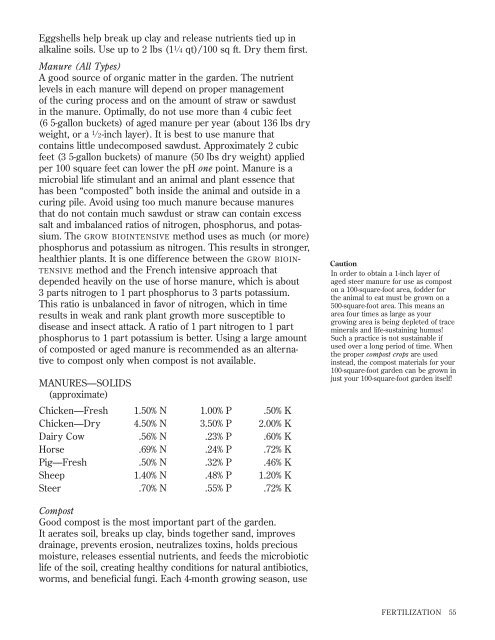How to Grow More Vegetables : And Fruits, Nuts ... - Shroomery
How to Grow More Vegetables : And Fruits, Nuts ... - Shroomery
How to Grow More Vegetables : And Fruits, Nuts ... - Shroomery
You also want an ePaper? Increase the reach of your titles
YUMPU automatically turns print PDFs into web optimized ePapers that Google loves.
Eggshells help break up clay and release nutrients tied up in<br />
alkaline soils. Use up <strong>to</strong> 2 lbs (1 1 ⁄ 4 qt)/100 sq ft. Dry them first.<br />
Manure (All Types)<br />
A good source of organic matter in the garden. The nutrient<br />
levels in each manure will depend on proper management<br />
of the curing process and on the amount of straw or sawdust<br />
in the manure. Optimally, do not use more than 4 cubic feet<br />
(6 5-gallon buckets) of aged manure per year (about 136 lbs dry<br />
weight, or a 1 ⁄ 2-inch layer). It is best <strong>to</strong> use manure that<br />
contains little undecomposed sawdust. Approximately 2 cubic<br />
feet (3 5-gallon buckets) of manure (50 lbs dry weight) applied<br />
per 100 square feet can lower the pH one point. Manure is a<br />
microbial life stimulant and an animal and plant essence that<br />
has been “composted” both inside the animal and outside in a<br />
curing pile. Avoid using <strong>to</strong>o much manure because manures<br />
that do not contain much sawdust or straw can contain excess<br />
salt and imbalanced ratios of nitrogen, phosphorus, and potassium.<br />
The GROW BIOINTENSIVE method uses as much (or more)<br />
phosphorus and potassium as nitrogen. This results in stronger,<br />
healthier plants. It is one difference between the GROW BIOIN-<br />
TENSIVE method and the French intensive approach that<br />
depended heavily on the use of horse manure, which is about<br />
3 parts nitrogen <strong>to</strong> 1 part phosphorus <strong>to</strong> 3 parts potassium.<br />
This ratio is unbalanced in favor of nitrogen, which in time<br />
results in weak and rank plant growth more susceptible <strong>to</strong><br />
disease and insect attack. A ratio of 1 part nitrogen <strong>to</strong> 1 part<br />
phosphorus <strong>to</strong> 1 part potassium is better. Using a large amount<br />
of composted or aged manure is recommended as an alternative<br />
<strong>to</strong> compost only when compost is not available.<br />
MANURES—SOLIDS<br />
(approximate)<br />
Chicken—Fresh 1.50% N 1.00% P .50% K<br />
Chicken—Dry 4.50% N 3.50% P 2.00% K<br />
Dairy Cow .56% N .23% P .60% K<br />
Horse .69% N .24% P .72% K<br />
Pig—Fresh .50% N .32% P .46% K<br />
Sheep 1.40% N .48% P 1.20% K<br />
Steer .70% N .55% P .72% K<br />
Compost<br />
Good compost is the most important part of the garden.<br />
It aerates soil, breaks up clay, binds <strong>to</strong>gether sand, improves<br />
drainage, prevents erosion, neutralizes <strong>to</strong>xins, holds precious<br />
moisture, releases essential nutrients, and feeds the microbiotic<br />
life of the soil, creating healthy conditions for natural antibiotics,<br />
worms, and beneficial fungi. Each 4-month growing season, use<br />
Caution<br />
In order <strong>to</strong> obtain a 1-inch layer of<br />
aged steer manure for use as compost<br />
on a 100-square-foot area, fodder for<br />
the animal <strong>to</strong> eat must be grown on a<br />
500-square-foot area. This means an<br />
area four times as large as your<br />
growing area is being depleted of trace<br />
minerals and life-sustaining humus!<br />
Such a practice is not sustainable if<br />
used over a long period of time. When<br />
the proper compost crops are used<br />
instead, the compost materials for your<br />
100-square-foot garden can be grown in<br />
just your 100-square-foot garden itself!<br />
FERTILIZATION 55












